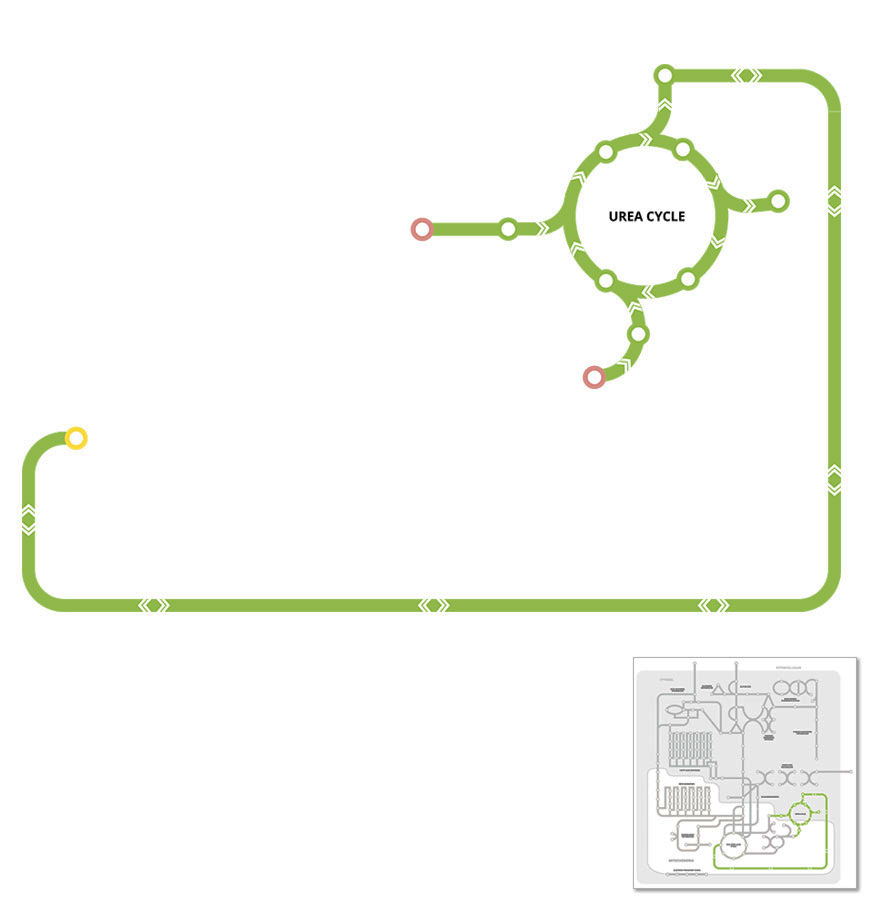
highlight all areas / label key areas

The Urea Cycle occurs almost exclusively in the liver (peri-portal cells). It prevents the toxic accumulation of ammonia generated through amino acid deamination by converting it into urea. The urea is then transported to the kidneys and excreted as waste in the urine.
Ammonia enters the cycle by reacting with carbon dioxide (CO2) to form carbamoyl phosphate, which then reacts with ornithine, the final product of the Urea Cycle, to form citrulline. The pathway also consumes aspartate and 3 ATP equivalents, producing both urea and fumarate:
NH4 + CO2 + 3ATP + Aspartate → Urea + Fumarate + 2ADP + AMP
The synthesis of citrulline occurs in the mitochondria, while the remainder of the cycle occurs in the cytosol. Fumarate can re-synthesise the aspartate needed for the Urea Cycle through citric acid cycle anaplerosis (see The Citric Acid Cycle pathway). This occurs through transamination of oxaloacetate, using glutamate as the nitrogen donor.
Key points:
The conversion of arginosuccinate to arginine releases fumarate in the following reaction catalysed by arginosuccinase:
Arginosuccinate → Arginine + Fumarate
Arginine continues as an intermediate of the Urea Cycle, while fumarate is imported back into the mitochondria, where it undergoes anaplerosis of the citric acid cycle (see The Citric Acid Cycle pathway). It can be used to re-synthesise the aspartate that is required for the Urea Cycle through the transamination of the resulting oxaloacetate (final product of the citric acid cycle), using glutamate as the nitrogen donor.
The urea produced by the Urea Cycle is released into the blood stream and it is filtered, resorbed and secreted by the kidneys.
In the cytosol, aspartate donates an ammonia group to citrulline that has been exported from the mitochondria to produce arginosuccinate:
Citrulline + Aspartate + ATP → Arginosuccinate + AMP + PPi
This reaction is catalysed by the enzyme Arginosuccinate Synthase.
Key points:
Citrulline is produced in the mitochondria as part of the Urea Cycle. It is exported to the cytosol in exchange for ornithine, where it reacts with Aspartate.
Ornithine is the final product of the Urea Cycle. It is produced in the cytosol but is transported back into the mitochondria in exchange for citrulline, where it reacts with carbamoyl phosphate to produce citrulline:
Ornithine + Carbamoyl phosphate → Citrulline + Pi
This reaction is catalysed by ornithine transcarbamylase (OTC) within the mitochondria.
Free ammonia enters the Urea Cycle by reacting with CO2 (or bicarbonate) and ATP to form carbamoyl phosphate:
NH4 + CO2 + 2ATP → Carbamoyl phosphate + 2ADP
This reaction is catalysed by carbamoyl phosphate synthetase I within the mitochondria. The free ammonia is typically derived from glutamine or glutamate, however other amino acids undergoing deamination can also contribute. Metabolism of nucleic acids and amines can also provide ammonia for this pathway.